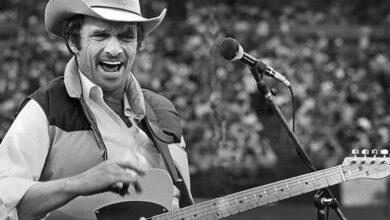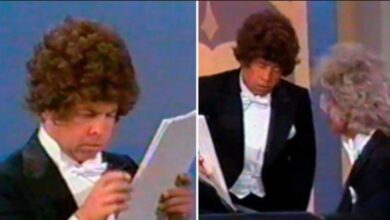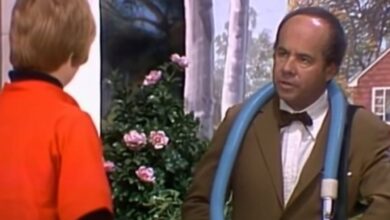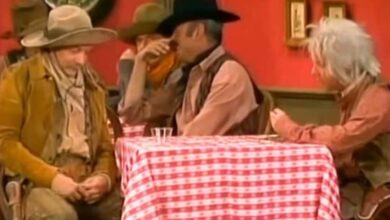How “I Am a Man of Constant Sorrow” Transformed Into an American Legend: The Soggy Bottom Boys and the Anthem That Defined a Generation
There are few songs in American music that bridge history and emotion as powerfully as “I Am a Man of Constant Sorrow.” Long before it echoed through cinema speakers in O Brother, Where Art Thou?, the tune already carried the weight of generations. Its rediscovery in 2000 turned what had once been a regional folk lament into a national obsession. The fictional Soggy Bottom Boys, with George Clooney at the front miming to Dan Tyminski’s voice, helped craft a scene so vivid that it reintroduced an entire genre to mainstream audiences overnight.
The story of this haunting ballad stretches back to the Appalachian hills of the early 1900s, when folk tunes were handed down like family heirlooms. In 1913, Dick Burnett, a blind fiddler from Kentucky, penned what would become the earliest recorded version. His lyrics, raw and mournful, spoke to the hardship and wandering that defined much of rural life. As the decades rolled on, artists like Emry Arthur and the Stanley Brothers gave the song new form, layering their voices over the same aching core of sorrow and perseverance.
Each era found its own echo in the song’s lament. Bob Dylan brought a weathered folk intensity to it in the 1960s, reimagining the melody through a modern lens. Yet it wasn’t until the dawn of the new millennium that the song would roar back into the cultural spotlight. In the Coen Brothers’ O Brother, Where Art Thou?, the track became a symbolic lifeline—a dusty, joyous anthem that carried three runaway convicts to redemption. Tyminski’s earthy vocals and T Bone Burnett’s immaculate production fused authenticity with cinematic flair, transforming an ancient ballad into an instant legend.
When the soundtrack hit shelves, it was as if the past had found a microphone. The album sold millions, not through slick marketing, but by striking something primal in listeners. Bluegrass, gospel, and old-time country suddenly filled radio waves that had long been ruled by pop. “I Am a Man of Constant Sorrow” stood at the center of that movement—haunting, uplifting, and fiercely alive. Awards poured in, including a Grammy for Best Country Collaboration, while record stores struggled to keep copies in stock.
The live renditions that followed only magnified its magic. The Soggy Bottom Boys, brought together from some of Nashville’s finest musicians, recreated the performance on stages across the U.S. and beyond. Every time the first line rang out, crowds erupted, clapping and singing like they’d known the words forever. There was something ancient yet immediate about it—an unspoken recognition of shared struggle, sung through a smile and a stomp of the foot. It was the rare case where a movie song outgrew the film itself.
Part of the song’s timeless pull lies in its message. Beneath its rustic charm is the story of endurance—the weary traveler who moves forward despite loss, exile, or pain. Its lyrics are simple enough for anyone to understand, yet profound enough to move anyone who has faced hardship. This universality keeps it alive, bridging generations and genres, resonating just as deeply with a modern listener as it did with mountain families a century ago.
After the film’s success, covers poured in from every corner of the music world. From Alison Krauss and Union Station’s soulful harmony to Billy Strings’ lightning-fast picking, artists brought new textures without losing the song’s aching heart. It became a rite of passage—a benchmark for bluegrass musicians to test their craft and prove they could channel both pain and pride in equal measure.
For the cast of O Brother, Where Art Thou?, the song became inseparable from their on-screen identities. George Clooney’s charm made the performance believable, even though his vocals were dubbed. His lip-synching became an art form of its own—so convincing that many fans assumed he was the one singing. The film’s barn dance and radio broadcast scenes, paired with “Constant Sorrow,” are still hailed as cinematic perfection, blending humor, myth, and music into one unforgettable sequence.
Offscreen, the song’s influence spread to real-life stages and festivals. From MerleFest to Telluride, jam circles erupted with its melody. Whether played by amateurs around campfires or by pros under spotlights, it inspired the same call-and-response energy that first electrified movie audiences. In a genre where tradition means everything, “Constant Sorrow” became both a standard and a shared language of endurance and joy.
What’s remarkable is how little the lyrics have changed since their first publication over a century ago. The themes of farewell, loneliness, and the uncertain road ahead remain untouched, proving that human struggle never really goes out of style. Each generation may phrase its pain differently, but the song’s melody keeps reminding us that endurance itself is a kind of grace.
For those who perform it, the song offers both challenge and reverence. It demands control, emotion, and humility—a balance few pieces can command. The Soggy Bottom Boys’ version set the modern benchmark, pairing tight harmonies with crisp instrumentation, showing how old music can still ignite new audiences without losing its soul.
Its ripple effect across pop culture was enormous. The Soggy Bottom Boys became household names, performing on major television shows and touring to sold-out venues. Suddenly, bluegrass found itself back in the cultural conversation, influencing not only musicians but filmmakers, who saw how authenticity could strike gold. The soundtrack’s runaway success opened doors for roots revival acts and inspired new generations to dust off banjos and mandolins.
Even today, the first few notes of “Constant Sorrow” can hush a crowd. Whether discovered on streaming platforms or heard live in a small-town bar, the song still hits the same emotional nerve. Its blend of sadness and defiance, tragedy and resilience, creates a timeless push and pull that speaks to anyone who’s ever weathered life’s storms and kept walking anyway.
Ultimately, “I Am a Man of Constant Sorrow” remains more than a piece of music—it’s an American myth in song form. Each rendition adds a new chapter to a story that refuses to fade. The Coen Brothers may have reintroduced it to the world, but its heart was forged in the dirt and dust of the Appalachians long ago, and it continues to travel—unchanged, unbroken, and forever sung.
So wherever you first heard it—on a movie screen, through a festival speaker, or in the hum of an old vinyl record—the song still feels like a confession whispered across time. The man of constant sorrow is all of us, still searching, still singing, still moving toward the next horizon.





